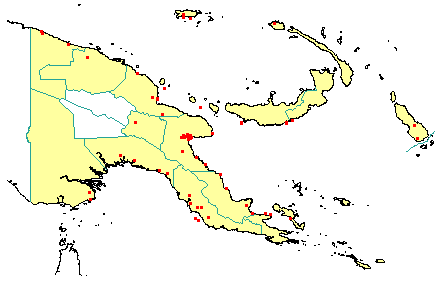
in PNGplants database
PNGTreesKey – Intsia bijuga Kuntze |
Barry Conn (NSW) & Kipiro Damas (LAE).
Guide to trees of Papua New Guinea
Copyright held by the authors, National Herbarium of New South Wales, and Papua New Guinea National Herbarium
Revisio Generum Plantarum Vol. 1: 192 (1891)
Other Literature: B. Verdcourt, A Manual of New Guinea Legumes 91-93 (1979) Fig. 20.
Family: Fabaceae
Dicotyledon
Timber Group: Major exportable hardwood Tradename: Kwila
Field Characters: Large canopy tree (up to 35 m high, rarely to 42 m) or Small sub-canopy tree (c. 10 m high); Bole cylindrical (up to 60 cm, sometimes to 90 cm diam.); straight (bole up to 20 m long); buttresses buttresses present (usually buttresses up to 2 m high); spines spines absent; aerial roots aerial roots absent; stilt roots stilt roots absent; Bark slightly red or bluish grey, rough (slightly (towards base of trunk) or smooth (above), scaly or flaky or pustular, lenticels rounded/swelling; Subrhytidome (under-bark) pale green; less than 25 mm thick, 5.0-6.0; bark blaze consisting of one layer; faintly to non-aromatic; outer blaze white (cream-coloured0), yellowish brown, or green, markings absent; inner blaze white (cream-coloured), yellowish brown, or green, markings absent; bark exudate (sap) present, colourless, not readily flowing (spotty), colour not changing on exposure to air, not sticky; terminal buds not enclosed by leaves.
Indumentum: Complex hairs absent; stinging hairs absent; mature twig indumentum (hairs) absent.
Leaves: Leaves spaced along branches, spiral (leaves occurring singly at a node and arranged spirally up the branchlet), compound (a leaf made up from two or more leaflets); petiole present, not winged, attached to base of leaf blade, not swollen; leaves with two leaflets or pinnate (unbranched with more than three leaflets) (2 pairs); petiolule not swollen; rachis present (when more than two leaflets), absent, absent; leaves without a terminal leaflet (the number of leaflets even - paripinnate), broadest below middle, 2.5-16.5 cm, 1.8-11.0 cm, leaflets opposite, asymmetric; venation pinnate, secondary veins open, prominent, intramarginal veins absent; leaves lower surface pale green, upper surface green (glossy), indumentum (hairs) absent or occasionally present, indumentum (hairs) sparse; absent; domatia absent; stipules present, joined, joined across twigs, encircling the twig, collar-like, not fringed, small, persistent.
Flowers: Inflorescence terminal, flowers on an unbranched axis or flowers on a branched axis, cones absent; flowers bisexual, stalked, flowers with one plane of symmetry, 13.0-33.0 mm long, diameter large (more than10 mm diam.); perianth present, with distinct sepals and petals whorls, inner perianth white, pink, or red; 1, some or partly joined; stamens 3 (plus 7 staminodes), present, joined, free of the perianth; ovary superior, carpels joined (when more than one), locules 1; styles solitary, 1.
Fruits: Infrutescence arranged on unbranched axis or arranged on branched axis, fruit 100.0-280.0 mm long, brown or almost black, not spiny, non-fleshy, simple, dehiscent, legume or loment; seeds 1-8, much more than 10 mm long, not winged, broad (as wide as long), seed more than 10 mm diam.
Distribution: West Sepik, East Sepik, Madang, Morobe, Eastern Highlands, Western, Gulf, Central, Northern, Milne Bay, Papuan Islands, New Britain, New Ireland, Manus & Bougainville.
 | Botanical records in PNGplants database |
Notes: Notes This species is classified in Fabaceae subfamily Caesalpinoideae.